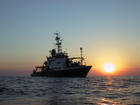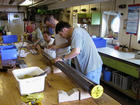Page path:
- Home
- Research
- Expeditions
- 2003
- M58/3
RV METEOR Cruise M58/3
Bremen, 20 January 2003
TRACING POISONOUS GASES IN THE OCEAN - Bremen`s Research Center Ocean Margins First Expedition on board RV "Meteor"
About one and a half years ago the Deutsche Forschungsgemeinschaft assigned the Research Center Ocean Margins to the University of Bremen. In the future the Center shall act as a center of excellence in the field of marine reserach. Having completed its building-up phase today the first marine research expedition is launched in Capetown. Geologists, geochemists, geophysicists, and oceanographers will examine exciting processes on and in the seafloor off Southwest-Africa. There are three legs with three main objectives:
¢ Leg 1 (January, 20 - February, 8)
The scientists analyze the sediment and the water column in order to reconstruct in detail the climate history of the Late Quarternary. They also want to find out more about the entrainment of warm water from the Indian into the Atlantic ocean; a process which ultimately effects the climate in the Northern hemisphere.
¢ Leg 2 (February, 11 - March, 12)
Geochemical, biological, and geological investigations close to the sediment-water interface to investigate the fate of carbon laden particles, which are transported from shallow coastal into deep ocean regions. This work is done in order to improve our knowledge of the carbon cycle which is relevant for the development of our climate.
¢ Leg 3 (March, 15 - April, 13)
The main objective of the last leg is centered around a strange phenomenon in the shallow waters of Southwest-Africa: namely regular eruptions of poisoning hydrogen sulfide. These gas discharges change the ocean`s blue colour into turquoise and result in extensive fish deaths.
¢ Leg 1 (January, 20 - February, 8)
The scientists analyze the sediment and the water column in order to reconstruct in detail the climate history of the Late Quarternary. They also want to find out more about the entrainment of warm water from the Indian into the Atlantic ocean; a process which ultimately effects the climate in the Northern hemisphere.
¢ Leg 2 (February, 11 - March, 12)
Geochemical, biological, and geological investigations close to the sediment-water interface to investigate the fate of carbon laden particles, which are transported from shallow coastal into deep ocean regions. This work is done in order to improve our knowledge of the carbon cycle which is relevant for the development of our climate.
¢ Leg 3 (March, 15 - April, 13)
The main objective of the last leg is centered around a strange phenomenon in the shallow waters of Southwest-Africa: namely regular eruptions of poisoning hydrogen sulfide. These gas discharges change the ocean`s blue colour into turquoise and result in extensive fish deaths.

The German research vessel "Meteor" cruising the South Atlantic Ocean

In the Geolab of RV "Meteor": working with sediment cores from the deep


